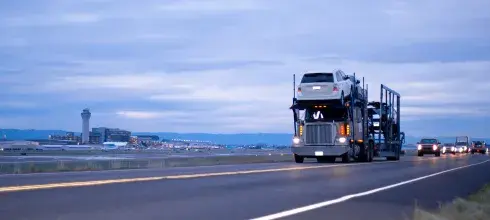Wherever you live in the United States, the environment affects your vehicle. If you’re near the ocean the salty sea air speeds up the rusting process and eats into your car’s exterior finish. For those who live near windy deserts, you’ve got the problem of sandblasted paint.
What about locations that are at high altitudes? There are some US cities that are at quite high altitudes, for example:
- Alma, Colorado - 10,361 ft (3,158 m)
- Leadville, Colorado – 10,150 ft (3,094 m)
- Blue River, Colorado – 10,020 ft (3,054 m)
- Breckenridge, Colorado – 9,600 ft (2,926 m)
- Flagstaff, Arizona – 6,910 ft (2,106 m)
- Big Bear City, California – 6,772 ft (2,064 m)
- Evanston, Wyoming – 6,749 ft (2,057 m)
- Steamboat Springs, Colorado – 6,732 ft (2,052 m)
- Durango, Colorado – 6,512 ft (1,985 m)
- Gallup, New Mexico – 6,468 ft (1,971 m)
If you already live in one of these high-altitude locations, you probably know what it does to your car. But for anyone who’s relocating to a high-altitude location, it can be a little confusing. Before you book your cross-country car shipping service, find out all there is to know about car adjustments for altitude.
Do cars need to be adjusted for high altitudes?
If you’ve ever driven between lowlands and mountains, you may have noticed that your car drives differently at different altitudes.
Think for a moment, how hard it is for you to breathe in higher altitudes. It’s no different for your car.
When you’re relocating to a mountain location it’s therefore important to check your car and tune it for higher altitudes. It’ll make getting around much better and be kinder on your car.
How to adjust your car for high altitudes
Altitude affects the way an engine produces power, among other things. This is because the amount of oxygen available is lower
The first step in high-altitude engine tuning is to do a basic tune-up. Make sure you change the spark plugs and points to types that are specified in the owner's manual. If your car has fuel injectors, there are no points to change.
Second step is to adjust the engine’s air/fuel mixture. It’s a common misconception that you should use an alternate spark plug as it will run more efficiently in higher altitudes. However, it’s more important to adjust the air/fuel mixture so that more air is flowing through the engine.
The final step is to adjust the engine idling. In higher altitudes, the levels of oxygen in the air are lower. For this reason, your engine idling needs to be raised. You’ll find how to do it in the car’s instruction manual. Alternatively, seek the advice and help of a professional car mechanic.
When you increase the idling, it allows for more air flow in and out of the engine. It increases the performance of the car’s engine at higher altitudes.
How to adjust your car’s carburetor for high altitude
A good rule of thumb to start the adjustment process is as follows:
Change main jet calibration by 6% for each 1,000m (3280’) altitude variation. For example, (if) normal main jet calibration at an altitude of 400m (1312’) is 0115, proper jet size for an altitude of 1400m (4592’) is 0110.
However, there isn’t a one size fits all answer. The final jetting set up for a car is generally determined through trial and error.
How high altitude affects your car in other ways
High altitudes can affect your car and its handling in a number of other ways.
Fuel efficiency
In general, cars are able to handle a wide variety of altitudes and geographic environments. However, at higher altitudes the air density is lower and there is less nitrogen, argon, and oxygen being pulled into the engine.
When these levels are low, it means the vehicle has to work much harder to burn off the fuel efficiently.
There are some trade-offs because lower fuel octane ratings now run the engine which affects fuel consumption.
If you want to do something to help, keep your fuel injectors as clean as possible.
Tire pressure
When you live and drive in locations that are high altitude it’s recommended that you check your tire pressure frequently. The lower temperatures can cause the tire pressure to decrease. If you’ve just shipped your car from somewhere that’s much warmer, check your tire pressures before you drive your car away. If they’re low, make sure you stop and get them filled correctly.
If your tires have the wrong pressure, you’ll experience poor fuel economy, steering/control issues, and uneven tread wear.
Engine air filter
You must keep your air filter clean at all times to ensure that the vehicle is getting as much pure air as possible. This will help it run efficiently. Remember to replace your air filter when necessary.
Brakes
Driving at high altitudes often means lots of roads that feature hills or tight corners. This means you’ll be putting extra wear and tear on your brakes. Remember to get your brakes checked regularly and replace them when recommended.
How high altitude can affect your car maintenance routine?
Knowing more about the effect of high altitude on your car is not everything. There are also different maintenance requirements you need to consider after you’ve shipped your car. Regular car maintenance is an important part of owning a car, but when you live in high altitudes, it’s even more essential.
You should undertake a few simple checks each month and take your car in for regular tune-ups. Only then can you be certain your car is operating at its peak performance and in the best condition possible.
Things you should be checking include:
Air filters
In a high altitude environment, your vehicle takes in less oxygen. It has to pull air harder in order to make the system work correctly.
To maximize airflow, the system has to be clean and working at its best. It’s impossible for it to do that when the air filter is clogged or dirty.
Tires
If you’ve got a new car, it’s probably got a sensor that alerts you when the tire pressure is low. If you haven’t got one of those sensors, you should check your tire pressures regularly, especially if you’re moving between low and high areas.
A good habit to learn is checking tire pressures when you fill up with gas or on a monthly basis. It only takes a few seconds and creates a much safer driving environment.
Power steering
When you’ve been driving along the highway, have you ever felt the power of the wind pushing against your car and moving it slightly? When you’re driving in the mountains, you’ll experience this more often because high winds can sneak up on you very quickly.
You’ll struggle to keep your car under control if your power steering system isn’t operational. Make sure you get it checked out regularly if you want to stay safe on the highway.
Brakes
More brake action is required when you’re driving up and down steep mountain roads. This puts more wear and tear on your braking systems. When you’re driving, pay close attention to the warning lights on your dashboard. It’s better to get potential problems checked out before they get worse.
Fuel injectors
When you’re driving at high altitudes, your vehicle is operating at a reduced pressure level. To help your car’s performance under these circumstances, it’s important to keep the fuel injectors clean. Only then can they deliver fuel into the system without causing a blockage.
Depending on the altitude, your vehicle could be operating at 20% less performance. If the fuel injectors are dirty or corroded, it will reduce the performance even more.
Now you know what you’ve got to do with your car when you relocate somewhere at high altitude, it’s time to book your auto transport service and make preparations to get there. Our shipping advisors can answer any questions, give you an instant quote, and make your booking. They’re available at the end of the phone so call (864) 546-5038) or by use Live Chat
Get a Free Instant Quote Today
FAQs
How do I prepare my car for high altitude?
There are several things you can do:
- Make sure the car’s fuel injectors are clean
- Have your engine tunes
- Check tire pressures are correctly
- Clean and replace the air filter if necessary
- Get your brakes checked and replace the brake pads if necessary
Does high altitude affect your car?
High altitude can affect your car in many ways:
- The engine makes be sluggish
- Fuel efficiency is reduced
- Tire pressures may be lower
- Extreme driving conditions increase wear and tear on the brakes
Does altitude affect a car's tune?
If the change in altitude is small, the carburetor will compensate and there is no need to make adjustments. However, for bigger altitude changes high altitude engine tuning of the carburetor may be needed.
Does fuel injection adjust for altitude?
Most modern vehicles that have fuel injectors are able to compensate for higher altitude automatically. The Electronic Control Module (ECM) adjusts the fuel mixture to prevent the engine from “running rich”.






